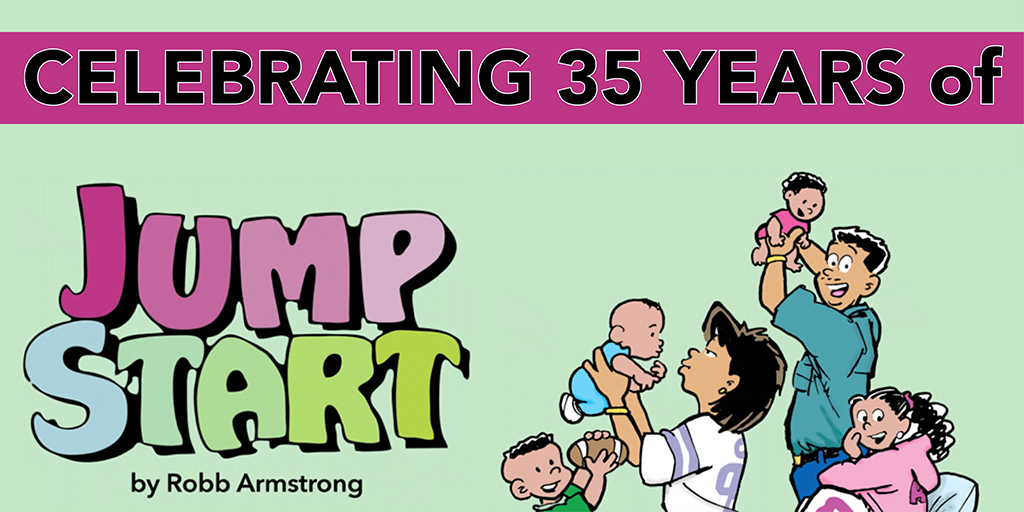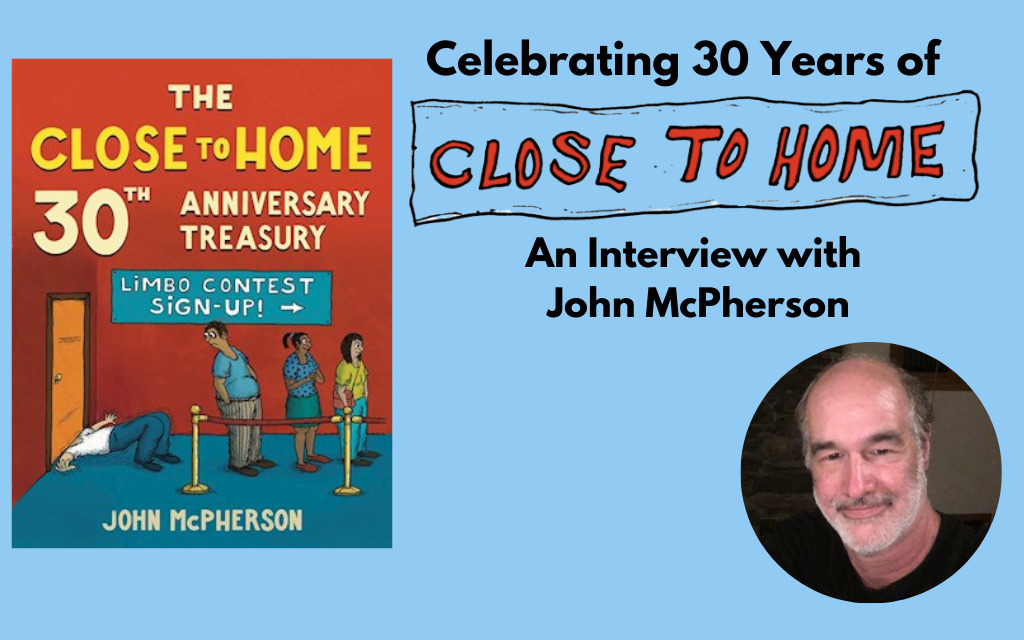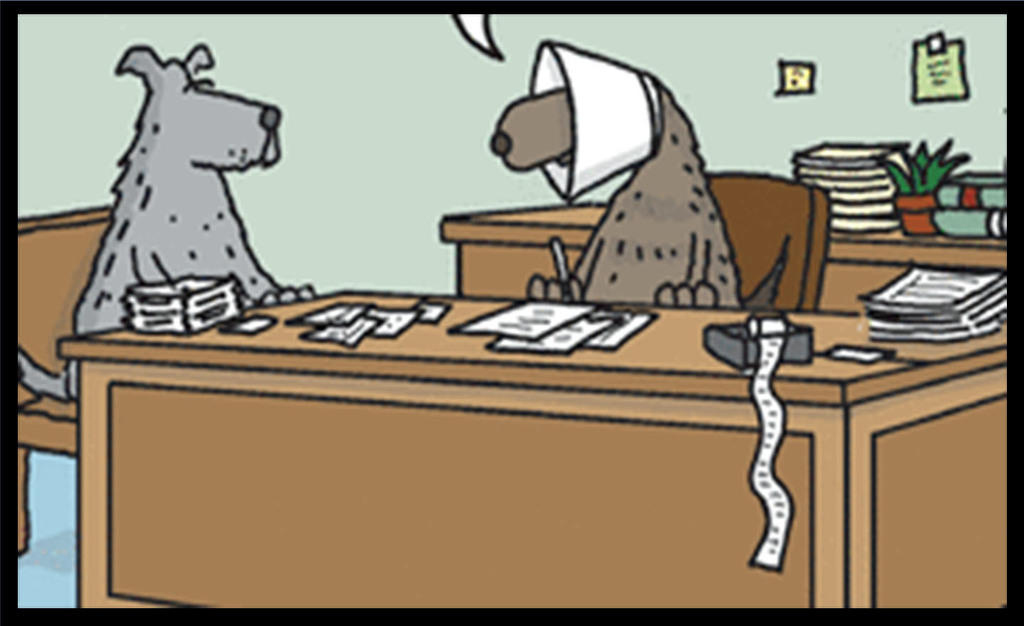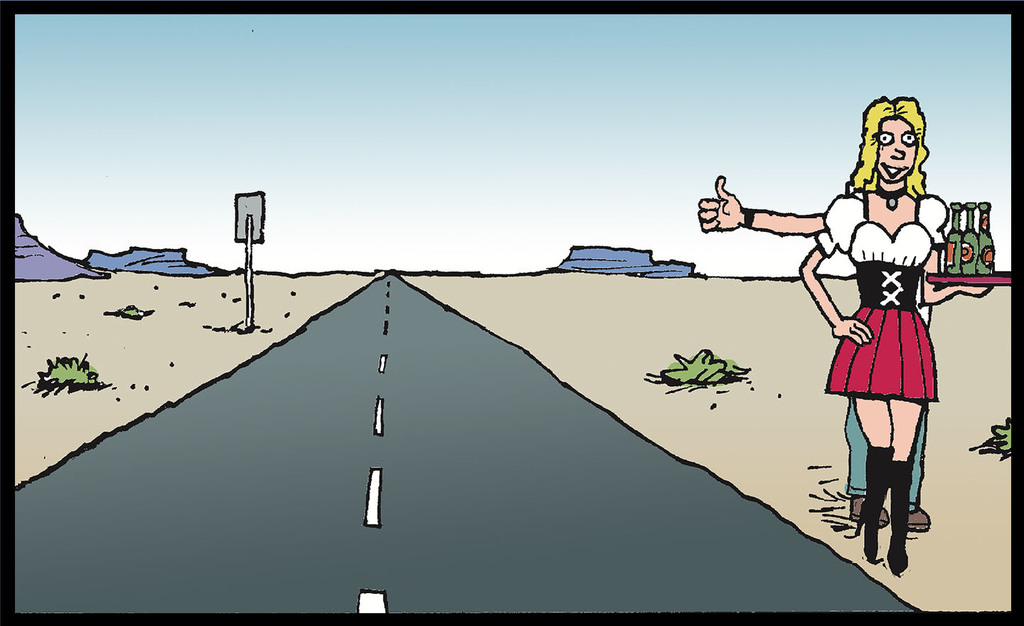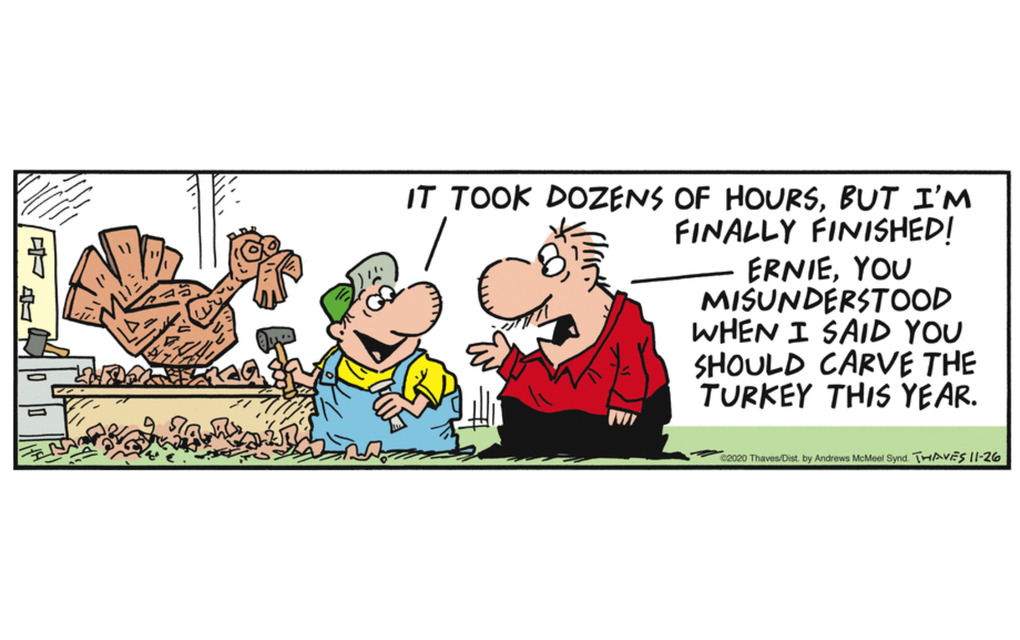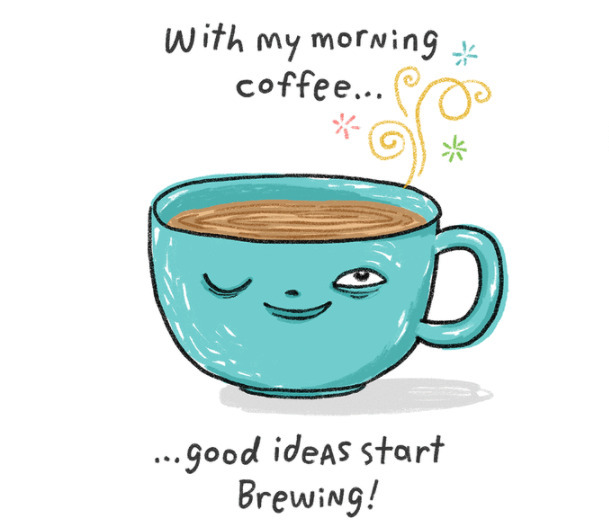Robb Armstrong (JumpStart)
by GoComicsThis latest "Meet Your Creator" post is a new and fresh take on our concept. JumpStart creator/cartoonist Robb Armstrong was recently interviewed by a student for a class project by aspiring cartoonist Jake. Based on the interview, Jake may have future options in journalism or blogging as well! Here is the Q & A between Robb and Jake. Enjoy...
JAKE: What inspired you to become a cartoonist?
ROBB: I have always loved to draw, even when I was too young to be any good at it. I used to really like the comic strip PEANUTS when I was little. I copied that artwork from a very young age, about 3 years old, until I could draw a recognizable "Charlie Brown" when I was about 5 or 6. I also loved cartoons on TV, especially "The Flintstones" . By the age of 10, I could draw a pretty good "Fred Flintstone" . I also liked a strip called, Wee Pals when I was a kid. Imagine my excitement when I signed my professional contract at the still young age of 27, and met my heroes, Charles Schulz (PEANUTS) and Morrie Turner (Wee Pals).
The thing about drawing cartoons that I loved the most was the reaction I was able to get from my family and friends. I discovered that the ability to draw is similar to performing magic. People stand in amazement watching it happen. Kids who wouldn't ordinarily be nice to me were super nice once they saw me draw my cartoons.
JAKE: What was your first "big break" ?
ROBB: In seventh grade, I began to struggle academically. This was partly because I had transferred to a private school. The Shipley School for Boys and Girls was very different from the public school I used to go to. For one thing, Shipley was formerly a school for girls. It was also my first time meeting students who were not African-American. I was in a new environment that challenged me in every way! Plus, the work itself was difficult for me, and my grades slipped. Badly. My math and science grades were so poor that Shipley decided to keep me in seventh grade an extra year. THIS TURNED OUT TO BE MY BIG BREAK! I learned to push myself harder than I was used to. I learned self-discipline. I learned to prioritize, and not spend too much time playing instead of working. These habits have come in handy as a professional cartoonist. My current deadlines are daily and I need to push myself mentally, and creatively. I need the self-discipline I learned when I was young to keep me on track today. Mostly, I simply learned to work very hard, no matter how I feel about the work itself.
I began to have a number of "big breaks" in high school and at Syracuse University. My high school began publishing my work, and at the age of 17, I sold political cartoons to a real big-city newspaper, The Philadelphia Tribune! I created a comic strip in college called "Hector" that ran in The Daily Orange newspaper for all four years of college. It was a hit with students and faculty.
Another "big break" came in 1987. Two years after graduating from Syracuse University, I met Morrie Turner, the creator of "Wee Pals" . He liked my work and introduced me to some of his colleagues in the comic strip industry. One friend was Mark Cohen, a collector of original comic art. He enjoyed my work as well. I didn't know it, but he was a friend of Charles Schulz and passed my work along to him! This led to my meeting Schulz's editor at United Feature Syndicate, where I was offered a contract in 1988. This was when I created JumpStart. Two years later, I met Schulz, himself, and began a friendship that lasted until his death in 2000.
JAKE: How much of your comic relates to happenings in reality? Do Joe and Marcy relate to anyone you know in real life?
ROBB: One night at dinner, my daughter(who was only about 6 at the time) said, "I can't eat that chicken" .
I said, "Why not?"
She said, "because I'm a vegetarian."
My wife said, "Since when?"
My daughter said, "Since tonight."
I said," well, that's fine, but you do know that you have to start eating vegetables. All vegetarians eat vegetables."
She said, I do eat vegetables! I love them!"
My wife said, "LIKE WHAT?"
My daughter said, "Like macaroni and cheese. THAT'S a vegetable!"
This is a true story that ended up being used directly in my comic strip! If something is true and funny, and works with the characters in my strip, I will use it. My characters are based on my family, but there are big differences. In JumpStart, Joe and Marcy have four kids, but in real life, my wife Crystal and I only have two (no real-life twins). Also, the characters have different careers than we do. Joe is a cop and Marcy is a nurse. In real life, I'm a cartoonist and my wife is an event planner. The inspiration comes from how the characters feel about each other, and how they respond to ordinary problems. I am always looking at life for situations that work well with the characters and feels natural and believable. Readers laugh when a strip is TRUE, moreso than when it is "funny" .
JAKE: Are you the only person working on JumpStart? Do you have colleagues working with you? Do you make up all of the ideas for each strip, or do you ever take some from fans like me? (If so, I'll get right to work!)
ROBB: Haha! Sorry Jake. I work alone on JumpStart. (Every day for 23 years.) I do have an Editor at Universal UClick, my syndicate in Kansas City, MO. His job is to make sure I meet my deadlines, and the strip contains no grammatical mistakes, or problematic language. The syndicate has artists who add color to the strip on GoComics.com during the week. I color the Sunday strips myself.
I do not solicit ideas or buy gags from outside writers. Some cartoonists do. It's not that other writers aren't good enough; it's just that JumpStart is my personal contribution to the world I live in. I enjoy coming up with my own ideas. Exercising my mind has kept me youthful. I am 51 years old, and appear to be 10 or 15 years younger. I attribute this to a zest for life and regular mental and physical exercise.
JAKE: What is the process to take your idea and turn it into the comic that appears in my driveway every Sunday morning? (You can skip the slow delivery boy; I've already had words with him.) I'd like to know about how you capture your ideas, the steps to make a rough drawing, how to convert it into an ink version, when and how you color it, and what it looks like when you submit it to newspapers.
I begin with a very rough drawing. This is mostly to figure out the composition, and to see if the strip has good timing. A comic strip should be sort of fast-moving in terms of the amount of words. At this stage, I am not concerned with the "beauty" of the artwork. There will be time for that during the inking. This stage is really about the writing and the concept itself. I'd read in a magazine on a flight from LA to Philadelphia that men shave 20,000 times in a lifetime. Ideas are all around us all the time. The skill is in recognizing a good possible strip when you see it. A lot of my ideas come during conversations with people. When someone is emotional about a topic, it means many people will relate to that topic. Extreme anger, happiness or sadness or love or commitment means many humans share that emotional connection to the topic. This is called "Universal appeal" . Comic strips are seen by people of all ages and races and needs this "Universal" quality.
I sketch out a frame that is 13 inches wide and 3 inches tall. I use ordinary Xerox paper or a cheap pad of paper from a dollar store. Six DAILY strips are due and one SUNDAY strip every Thursday.
Once I'm happy with the rough sketch, I tape it down to a lightbox. (This is a box with a glass on top and a light bulb in the middle.) Then I tape finger-painting paper over the rough. (I use children's finger-painting paper because of its durability and how it holds a rich, non-blurry black line. I draw with a Papermate Flair Pen you can find at CVS or Office Depot) I then trace the rough, trying to retain as much of the loose energy as possible. I love the look of my roughs, and want the finish to look lively as well. Next, I handle the lettering. Sometimes, I improve the wording at this point. You can see an example of this in the rough sample here:
Each letter must be drawn big, clear and easy to read! Each word must have room around it, and once inside the balloon, the words must float in the center of that space evenly. Kids really struggle in this area. I once taught cartooning to children. I have rarely met a child who is good at lettering, and it is by far the most important aspect of the final comic strip! Practice lettering every day. I used to draw the alphabet from A to Z repeatedly until I had handsome lettering that came naturally.
I do lettering first, then balloons, then frames, then characters, then backgrounds. (Don't put too much stuff in backgrounds!) Each daily strip takes two hours from start to finish. Sunday strips take three hours each.
I never rush or draw lazily.
Once the inking is complete, I untape the finish and the rough from the lightbox. I store the rough in my files. I make a clean copy of the original work (at 80 per cent to fit on my scanner) and store the original. I do sell these, but they are expensive. (A single JumpStart original costs $300.00 for a daily strip, and $500.00 for a Sunday strip.)
I scan the reduced copy into Photoshop. I then clean up any errors or stray marks. I create two versions of each comic strip. One is clean line art, to be used on GoComics.com (a colorist at my syndicate will color this version per my direction) and the other version has gray tones, which is what is printed in most newspapers. This is all done in Photoshop, a step which takes another three additional hours for a week of strips. I color the Sunday myself using a numbered guide (990 is red, 003 is blue, etc.) Once the strip is ready, I send it digitally to my syndicate in Kansas City. Before computers, this was done via FedEx and was an expensive headache. Now it is done inside a software program called FTP. It's a breeze! Sure beats chasing a FedEx truck down the street!
I am not involved past this stage. Getting to your driveway is the job of my syndicate and the newspaper companies, themselves. Having worked on my college newspaper, I know that their steps are labor-intensive and arduous! Even the paperboy is sweating to get there!
Good luck with this project, Jake, and in your future career in this exciting field!
-Your friend
Robb Armstrong
Read Robb Armstrong's JumpStart online and on our GoComics mobile app. Learn more about Robb by visiting his webpage. Like Robb Armstrong on Facebook and follow him on Twitter.


